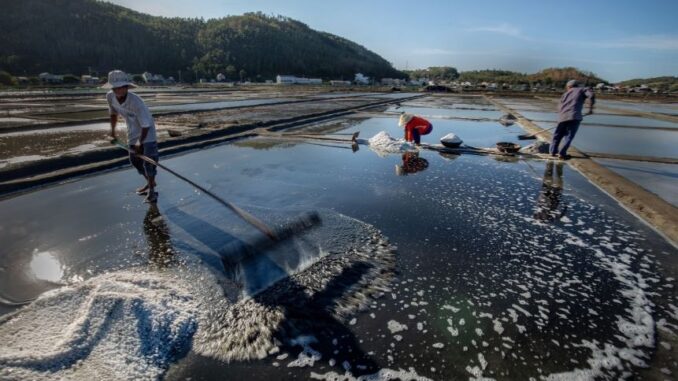
9x Le Hoang Men learn about craft villages from fishing in Tam Giang lagoon, steaming Quy Nhon fish or making Sa Huynh salt.

Fishing village in Ngu My Thanh village, Quang Loi commune, Quang Dien district, Thua Thien – Hue. Quang Loi lagoon belongs to Tam Giang lagoon, where fishing activities and market meetings take place at dawn.
The photo is part of the photo series “Colors of the Central Coastal Craft Villages” by Le Hoang Men (29 years old), a native of Dong Nai, now working at a media company in Ho Chi Minh City. I have been interested in photography since 2013, especially taking pictures of daily life and craft villages along the central coastal provinces. Currently, Men have taken 11 sets of photos of traditional craft villages in Thua Thien – Hue, Quang Nam, Binh Dinh, Phu Yen, and Quang Ngai.

The people of the sampan consider boats as both a house and a means of living. Thanks to favorable trade and trade, life in Ngu My Thanh is getting better and better. People expect favorable farming and settlement to go ashore but still be able to maintain aquaculture and fishing.

The fish market in Ha Loc village, Tam Tien commune, Nui Thanh district, about 15 km from Tam Ky city, has been operating from midnight to morning and has been bustling for more than 15 years. The market is considered as a source of seafood for Quang Nam and neighboring provinces.

At dawn, fishing boats docked, the seafood trade takes place right on the beach with all kinds of fresh fish, squid eggs, shrimp, crabs, and crabs. Each fishing boat has about 3-4 people and after a fishing trip after deducting expenses, it is 5-6 million VND.

Phu Yen has many traditional coastal villages such as processing seafood, fish sauce, weaving mats, making rice paper or making baskets… Pictured is the stage of trawling anchovies at Hon Yen in Nhon village. Hoi, An Hoa, Tuy An, seen from above, the net is like a “radiating flower”.

“While taking pictures of the Milky Way with my brothers in Hon Yen, I caught sight of an anchovy steamer in operation, it was around midnight, I saw people steaming fish and asked to go there to take pictures. moments. The series of photos brought me many interesting experiences, many good memories, and hospitable people in Phu Yen”, Men shared.

The stages of catching and processing anchovies are hard work, but people try to keep this traditional profession. After ashore, fish are taken to manual drying ovens for preliminary processing through three stages of selection, steaming and drying. Each kiln creates jobs for over 20 workers. After preliminary processing, fish are bought by traders and businesses inside and outside the province for processing and export. In addition, anchovies are also used to make fish sauce.
The photos in the fish steamer of Men’s photo series “Phu Yen develops traditional coastal craft villages” won the first prize of the Vietnam Beauty photo contest with the theme of Traditional Crafts in May 2021 by People’s Television. organization.

Quy Nhon fish steaming village, Binh Dinh is one of the long-standing traditional craft villages bearing the imprint of the Central region. This profession of steaming fish was born more than half a century ago at a fish market located along Ham Tu wharf, commonly known as “steaming fish hamlet”.

Boats carrying fresh fish from the sea are bought by the kilns, usually squid, scad, anchovies, striped fish or tuna. Then comes the preliminary processing stages such as scaling, gutting, cutting the gills and neatly stacking them in bamboo baskets to wait for them to be steamed in the oven. Steamed water is mixed according to its own recipe to ensure the rich taste of sea fish. Men say people work very hard late at night, requiring good health and persistence in the profession.

Visitors to Quang Ngai will experience the Sa Huynh salt-making village in Pho Thanh, Duc Pho, 60 km from the city center. This is a large salt basin of the Central region, with an area of more than 110 hectares. From March to August every year, the scene of people busies working under the hot sun.

Salt-making is mainly manual, based on the rising tide, salt people bring water from canals and ditches, put it in water tanks and then put it in the field, waiting for the sun to crystallize enough to form a salt. In the photo are salt harvest women wearing full-face coverings and gloves to withstand the harsh sun. Finished scraping salt is poured onto trolleys and transported to the gathering place.

The salt barn dates from the 19th century is one of the cultural vestiges left in the cultural space of Sa Huynh, currently, the salt-making method of the salt people here still retains the tradition as in the beginning. In 2011, Sa Huynh salt was recognized as an exclusive trademark by the National Office of Intellectual Property, Ministry of Science and Technology.
“This series of photos of craft villages along the central coast depicts the colorful beauty of workers in the rhythm of their livelihoods and depicts the human and cultural values of the Vietnamese people. The experience of composing a craft village is also a loving connection with the people in the places where I have been”, Men shared. Follow vnexpress
Photo: Le Hoang Men
